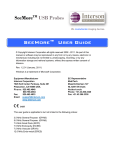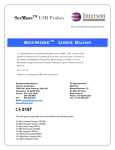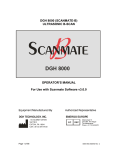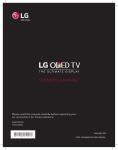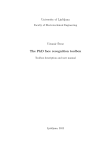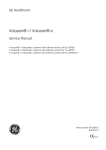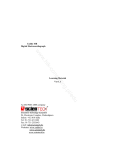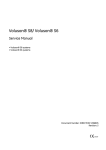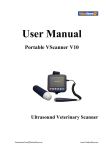Download ywarning - GlobalMed
Transcript
ClearProbe™ USB Ultrasound User Guide © Copyright GlobalMed Corporation all rights reserved. No part of this manual or software may be reproduced in any form or by any means, electronic or mechanical, including but not limited to photocopying, recording, or by any information storage and retrieval systems, without the express written consent of GlobalMed. Windows is a trademark of Microsoft Corporation ClearProbe USB Ultrasound is a trademark of GlobalMed Equipment Manufacturer GlobalMed Corporation 15020 North 74th Street Scottsdale, AZ 85260 USA Phone: +1.480.922.0044 Fax: +1.480.922.1090 Email: [email protected] Website: www.GlobalMed.com Information in this document is subject to change without notice. 0197 This user guide is applicable to but not limited to the following probes: 3.5 MHz General Purpose (GP/AB) 5.0 MHz General Purpose (GP/AB) 7.5 MHz Small Parts (SP/PI) 7.5 MHz Endocavity (EC/EB) 7.5 MHz Vascular (SR/VA) 7.5 MHz Endorectal (ER/ES) 12.0 MHz Endorectal (ER/ES) 12.0 MHz Micro-Vascular (MV/NV) Table of Contents 1. Introduction 2. Minimum System Requirements 3. Warnings, Safety Information 3.1. Meaning of Signal Words 3.2 Meaning of Safety Symbols 3.3. General Cautions and Warnings 3.4. Operator Qualifications 3.5. Care and Handling of Probes 3.6. Cleaning and Disinfection 3.7. Probe Cleaning 3.8. Probe Disinfecting 3.9. Surface Cleaning 3.10. Surface Disinfection 3.11. Acoustic Energy 3.12. Electromagnetic Compatibility (EMC) 3.13. Prescription Device Statement 3.14. Training 4. General 5. ClearProbe Display 6. ClearProbe User Controls 6.1. Auto Scan Tab 6.2. Advanced Scan Tab 6.3. Patient Tab 6.4. Settings Tab 6.5. Measure Tab 7. Saving, Viewing, and Printing Images 8. Electromagnetic Compatibility 9. Storage 10. Transportation 11. Care of the USB Probe 12. Disposal Appendix A - ClearProbe Software Installation Appendix B - GlobalMed Probe System Specifications Appendix C - Computer System Specifications Appendix D - GlobalMed Probes and their Applications Appendix E - Summary of the Acoustic Quantities Appendix F - GlobalMed ClearProbe Probes - Indications for Use Appendix G - Patient Privacy and Confidentiality 01-9911-00 ClearProbe User Guide Revision 5 2 2 2 2 3 3 4 4 5 5 6 7 7 7 7 7 7 8 8 9 9 10 11 12 13 14 15 16 16 17 17 18 19 20 21 22 30 33 1 1. Introduction Congratulations on your purchase of the GlobalMed USB Ultrasound Imaging Probe, the ultrasound imaging probe that plugs into the USB port of your computer. Please review this user guide before you begin scanning. Contact GlobalMed or your sales representative if you have any questions. Note: There is also an embedded Help Guide in the ClearProbe software. Note: The sale of this item is subject to regulation by the U.S. Food and Drug Administration and state and local regulatory agencies. 2. Minimum System Requirements Computer Operating System: Windows 7, 8 Minimum processor: 2.5 GHz Minimum RAM: 4 GB RAM USB 2.0 port 3. Warnings, Safety Information 3.1. Meaning of Signal Words In this User’s Manual, the signal words “Warning” and “Caution” are used regarding safety and important instructions. These signal words and their meanings are as follows. All users of the GlobalMed Ultrasound Probe System must understand the meanings of these signal words. Signal Word Meaning YWARNING Indicates a potentially hazardous situation which, if not avoided, could cause injury or harm to the equipment. Y Indicates a potentially hazardous situation which, if not avoided, may result in minor injury or harm to the equipment. CAUTION CAUTION Indicates a potentially hazardous situation which, if not avoided, may result in property damage. Type BF Equipment 01-9911-00 ClearProbe User Guide Revision 5 2 3.2 Meaning of Safety Symbol s Follow Operating Instructions Y 3.3. “Attention”, refer to User’s Manual General Cautions and Warnings Y CAUTION Probes must be cleaned after each use. Cleaning the probe is an essential step prior to effective disinfection. Follow the manufacturer’s instructions when using disinfectants. Y WARNING Do not allow sharp objects, such as scalpels or cauterizing knives, to touch probes or cable. Y WARNING Equipment not suitable for use in the presence of flammable mixtures. Y WARNING If the probe is used with other devices, current leakage may increase and electric shock may be caused. It is the user’s responsibility to ensure safety when the probe is to be used with other devices. If safety cannot be ensured, use of the probe with other devices is not allowed. Y WARNING The use of a non EN 60601-2 approved AC Adapter could potentially cause harm to the system, the probe, the operator and / or the patient. Y WARNING Do not touch the USB probe System’s USB cable connector and the patient simultaneously. Y WARNING USB Probe System is not to be used with HF surgical equipment. Y WARNING Do not submerse USB Probe System in water Y WARNING No modification of this equipment is allowed. Attempting to modify or service the equipment may result in safety hazards and performance degradation and / or failure. 01-9911-00 ClearProbe User Guide Revision 5 3 3.4. Symbology The following symbols may be used on GlobalMed labeling: Symbol for “Serial Number” REF Symbol for “Part Number” Symbol indicating the “date of manufacture” Type BF Equipment Follow Operating Instructions 3.5. Operator Qualifications The medical professional operating the USB ultrasound probe system must have a general knowledge of the use of ultrasound imaging devices and imaging protocols. Do not plug in the ultrasound probes until the software has been fully installed. See software installation guide in Appendix A, page 18. Do not use in the presence of flammable anesthetics or other flammable materials. GlobalMed probes use very low acoustic power output, and ultrasound imaging has been found, in many studies, to be safe when used correctly. However, as with all medical procedures, risks and benefits must be weighed. It is important to use the lowest power settings and the shortest scan times possible while attaining the needed clinical information. 3.6. Care and Handling of Probes Although GlobalMed probes are very durable, reasonable care must be taken to avoid damaging them. Handle the membrane on the tip of the probe and the cable attachment at the other end of the probe with care. Keep the probe membrane away from sharp objects to avoid damage. Clean and store the probe in its padded case. This will protect the probe and the delicate scanning membrane. Do not put stress on or use the cable to carry the probe, as this may damage the probe and cable. Your probe should give you many years of reliable service if these simple precautions are followed. 01-9911-00 ClearProbe User Guide Revision 5 4 3.7. Cleaning and Disinfection Y WARNING Always disconnect the ultrasound probe system from the host computer before performing maintenance or cleaning. Y WARNING Always follow the manufacturer’s instructions when cleaning and disinfecting probes and biopsy guide adapters. Y WARNING Do not use a surgeon’s brush when cleaning probes. The use of even soft brushes can damage the probe. 3.8. Probe Cleaning Repetitive cleaning of the USB Ultrasound Probe System is capable of withstanding, without damage or deterioration of the safety provisions, the cleaning and/or disinfecting process specified in this manual and the instructions for use. 1. Wear protective gloves when performing the cleaning process. 2. Disconnect the probe from the system. 3. Remove any sheaths, biopsy guide adapters, and biopsy needle guides. 4. Discard sheaths (sheaths are a single-use item) in a biohazard container. 5. Use a soft cloth lightly dampened in a mild soap or compatible cleaning solution to remove any particulate matter or body fluids that remain on the probe or cable. 6. To remove remaining particulates, rinse with water up to probe’s USB cable connection. 7. Wipe with a dry cloth; or wipe with a water-dampened cloth to remove soap residue, and then wipe with a dry cloth. 01-9911-00 ClearProbe User Guide Revision 5 5 3.9. Probe Disinfecting A 10-6 reduction in pathogens should be reached following the disinfecting procedures in this manual and using the following recommended solutions. The following disinfectants are recommended because of both biological effectiveness (as qualified through the FDA 510(k) process) and their compatibility with GlobalMed ultrasound product materials. Solutions Country Type Active ingredient FDA 510(k) Cidex® USA Liquid Gluteraldehyde K934434 Cidex Plus® USA Liquid Gluteraldehyde K923744 1. Wear protective gloves when performing the disinfecting procedure. 2. Check the expiration date on the solution that is being used solution is used. 3. Use only solutions that are within the expiration date. Y WARNING The type of tissue it will contact during use dictates the level of disinfection required for a device. Ensure that the solution strength and duration of contact are appropriate for disinfection. Be sure to follow the manufacturer’s instructions. Y WARNING Using a non-recommended disinfection solution, incorrect solution strength, or immersing a probe deeper or for a period longer than recommended can damage or discolor the probe and will void the probe warranty. Y WARNING Do not immerse probes longer than one hour. Probes may be damaged by longer immersion times. Y WARNING Disinfect probes using only liquid solutions. Using autoclave, gas (EtO), or other non-GlobalMedapproved methods will damage the probe and void the warranty. 1. Mix the disinfection solution compatible with the probe according to label instructions for solution strength. A disinfectant qualified by the FDA 510(k) process is recommended. 2. Immerse the probe into the disinfection solution per the manufacturer’s recommendations of duration. 3. Follow the instructions on the disinfection label for the duration of probe immersion. 4. Using the instructions on the disinfectant or sterilization label, rinse the probe up to the point of immersion, and then air dry or towel dry with a clean cloth. 5. Examine the probe for damage such as cracks, splitting, fluid leaks, or sharp edges or projections. If damage is evident, discontinue use of the probe and contact a customer service representative. 6. Draping: For endocavity scanning, a clean/non-sterile drape or condom covering may be used. Ultrasound does not penetrate through air, so you must put scanning gel on the inside of the drape, as well as some couplant (gel or water) between the outer surface of the drape and the region being scanned. 01-9911-00 ClearProbe User Guide Revision 5 6 3.10. Surface Cleaning Refer to “Probe Cleaning” (3.7, page 4) 3.11. Surface Disinfection Refer to “Probe Disinfecting” (3.8, page 4 and page 5) Y WARNING Do not immerse the probe or use heat or radiation to sterilize it. This will permanently damage the probe and void the warranty. 3.12. Acoustic Energy The effects of acoustic energy on human tissue are currently under investigation. Therefore, it is recommended that diagnostic ultrasound output power be set to the lowest possible levels in accordance with the principle of ALARA (As Low As Reasonably Achievable). See section 6 of this manual for Acoustic measurements. 3.13. Electromagnetic Compatibility (EMC) The GlobalMed GP, EC & SP family of USB powered ultrasound probes have completed and passed EN 60601-1-2: 2007 standard. 3.14. Prescription Device Statement Y CAUTION US Federal law restricts this device to sale by or on the order of a physician. Y WARNING The sheath may contain natural rubber and talc, which may cause allergic reactions. For more information, see the FDA’s March 29, 1991, Medical Alert on latex products. 3.15. Training This USB probe system is intended to be used by trained medical professionals only. The specific probe functions are described in this manual and are also available through the ClearProbe system software Help Menu. 01-9911-00 ClearProbe User Guide Revision 5 7 4. General This user guide is for the Interson USB probe system. Prior to using the probe, become familiar with the operating instructions in this guide. The USB probe system is a unique concept where the ultrasound system is built entirely into the probe. This USB probe system allows the user to image in real-time and review cine or freeze-frame images on the screen in B-Mode scan format. ! WARNING Prior to patient evaluation, inspect the USB Ultrasound Probe System for any physical damage such as leaking fluid and/or cracked and/or broken: membrane; housing; strain relief; stand-by switch; USB cable. If physical damage exists, do not use for patient evaluation and return to Interson for service evaluation. 5. SeeMore Display The computer monitor screen is divided into three major sections: On the left side is the Imaging Window and the Status Window. The Imaging Window displays the ultrasound scan, and includes measurements, calculations and annotations. The Status Window displays patient information for the active exam and details about the probe and its settings.On the right side of the screen is the User Interface Window. It contains a number of tabs to adjust the image, input patient and exam information, set preferences, and perform measurements and calculations. Each of these tabs and their functions are described in detail in this User Guide. Imaging Window User Interface Window Status Window Note the blue dot on the upper left side of the image. This blue dot corresponds to the scan / freeze and image orientation button on the probe. The radiologist’s convention is that the orientation mark on the image identifies the patient’s right side or the patient’s head. The image can be flipped and/or inverted in the Settings tab. 01-9911-00 SeeMore User Guide Revision 5 8 6. User Controls The User Interface Section on the right side of the screen contains five tabs, Auto Scan, Adv. Scan, Patient, Settings, and Measure. Each of these tabs has its own page in this Quick Start Guide. Video and embedded help are also available for each of these tabs. To access Video Help, select a tab and then use the Help pull down in the upper left corner of SeeMore and select Video Help. To access embedded help, select Help in the upper left corner of SeeMore and select Help Topics. 6.1. Auto Scan Tab The Auto Scan tab is the default view. You may select different presets and adjust basic functions such as depth, frequency, intensity and contrast from this tab You may adjust the Intensity and Contrast. It is typically best to leave these in the center. Probe Select identifies all connected probes and enables you to select which probe you would like to use. Select the pull down arrow to view the list of connected probes Preset enables you to select from any included presets of ultrasound parameters. A specific preset contains: Intensity, Contrast, Near Gain, Mid Gain, Far Gain, Frequency, Depth, and Power. The list of available presets changes based on the probe that is selected. Presets are saved and deleted in the Adv. Scan tab. Frequency allows you to select from available pulse frequencies. Pulse frequencies are probe specific, and as such, different probes may have different pulse frequencies. As image resolution is better at higher frequencies, always use the highest pulse frequency that allows you to scan to your desired depth. Depth changes the displayed depth range. Depth ranges are dependent on the probe and the selected pulse frequency. Scan starts and stops the scan. The scan button on the probe and the keyboard’s space bar will also start and stop the scan. SeeMore automatically saves the most recent frames. After stopping a scan the most recent frames can be replayed by pressing the Cine play button. The number of frames that are automatically saved in the cine frames buffer is selected in the Settings tab. Image Save stores the current displayed frame of native format scan data and also a jpeg with measurements and annotations. Image Load recalls a saved frame of native format raw scan data. Cine Save stores the buffer of most recent scan frames. Cine Load recalls a previously saved buffer of the most recent scan frames. 01-9911-00 SeeMore User Guide Revision 5 9 6.2. Advanced Scan Tab The Adv. Scan tab has the same functionality as the Auto Scan tab, as well as the capability to adjust the image’s gains and pulse power, and save presets. In the right hand column of sliders you can adjust the Intensity and Contrast. Typically you will leave these in the center. Power controls the probe’s pulse power. Typically, Power will be at the maximum unless the image is saturated with the Gains centered. In the left hand column of sliders you can adjust three gains. Start with all three gains in the center. If the image is saturated, lower the Power. Lower Power typically provides better images when imaging a bladder or fetus. Near Gain adjusts the first third of the image. Mid Gain adjusts the middle third, and Far Gain the last third. An alternative adjustment method is to adjust all gains to the minimum (left), pulse power to maximum (right), and intensity and contrast in the middle. Now, increase the Near Gain until the first third of the image is just below saturation. Similarly, adjust the Mid Gain, and finally the Far Gain. Probe Select identifies all connected probes and enables you to select which probe you would like to use. Only one probe can be active at a time. Preset enables you to select from an included preset of ultrasound parameters. A specific preset contains: Intensity, Contrast, Near Gain, Mid Gain, Far Gain, Frequency, Depth, and Power. The list of available presets changes based on the probe that is selected. To save a new preset, type a new name over an existing preset name and select Save Settings. To delete a preset, select the preset name and then press delete on the keyboard. Frequency allows you to select from available pulse frequencies. Pulse frequencies are probe specific, and as such, different probes may have different pulse frequencies. As image resolution is better at higher frequencies, always use the highest pulse frequency that allows you to scan to your desired depth. Depth changes the displayed depth range. Depth ranges are dependent on the probe selected and the selected pulse frequency. Scan starts and stops the scan. The scan button on the probe and the keyboard’s space bar will also start and stop the scan. ClearProbe automatically saves the most recent frames. After stopping a scan the most recent frames can be replayed by pressing the Cine play button. The number of frames that are automatically saved in the Cine frames buffer can be set in the Settings tab. Image Save stores the current displayed frame of native format scan data and also a jpeg with measurements and annotations. Image Load recalls a saved frame of native format raw scan data. Cine Save stores the buffer of most recent scan frames. Cine Load recalls a previously saved buffer of the most recent scan frames. 01-9911-00 ClearProbe User Guide Revision 5 10 6.3. Patient Tab The Patient tab is where new patients are entered and selected prior to starting an exam. New patient information can be typed over current information, or Clear Fields will remove all displayed information without deleting a patient from the database. A new patient can be entered or an existing patient can be edited. After editing or entering the patient information, select Save and follow the prompts to add as a new patient or edit the current patient. Facility and Clinician are selected and saved with the patient. They are entered and edited in the Settings tab. Sort alphabetically sorts the database by Last Name. If Sort is not checked, patients are displayed in the order they were entered. Start Exam posts the current patient information to the Status Window and makes a patient folder in the Documents/ClearProbe Data/Patient Data directory. Images and calculations are stored to this folder. Start and then stop/freeze a scan. You may use either the Scan button on the screen, the button on the probe, or the keyboard space bar. Images are saved each time Save Image is pressed. Prior to pressing Save Image, you may scroll to a specific image by using the arrow keys on the keyboard or the scroll wheel on the mouse. You may add measurements, annotations, and calculations prior to pressing Save Image. To end a patient exam press Stop Exam. After an exam is completed, Print will print a single page report for the selected patient Last Name. The report is driven from a customizable template. The standard template prints a single page report of the patient information and the first four saved images. The report template may be modified to arrange text and images and to modify the number of images that are included in the report. Contact GlobalMed or your distributor to learn how to modify the report template. Images, calculations and measurements that are conducted here in the Patient tab are automatically associated with a specific patient if Start Exam has been pressed. To make a calculation or measurement that is not associated with a specific patient select the Measure tab; make calculations and measurements, and optionally save and print single images. 01-9911-00 ClearProbe User Guide Revision 5 11 6.4. Settings Tab The Settings tab is used to configure the functions of ClearProbe. In the Facility block you can Add and Remove either Facility or Clinician names. To remove a name, highlight the facility or clinician name and select Remove. To add a new name, type over an existing name and select Add. The previous entry is not edited, the new entry is added. Report Copy lists any connected storage drives and allows you to select a location to store a duplicate copy of patient exams. Patient Data Folder specifies the location for patient data and exams. You can select Browse and modify the default location. By specifying a network folder, ClearProbe will automatically make all patient folders in, and send all patient data to, the network location. Grid displays reference marks on the left side of the Image Window. Auto Save specifies whether the space bar or the probe button automatically saves images to the patient’s folder during an exam. The default is OFF as the user has much more control over which image to save using Save Image, after selecting Start Exam in the Patient tab. Centerline displays a reference line in the center of the image. A Biopsy Guide reference line can be displayed if an endocavity probe is the selected probe. Cine Frames allows the user to specify the number of frames that are buffered for replay. 32, 64,128, 256, 512, 1024 or more may be selected. As the frame rate is approximately 15 frames per second, these equate to approximately 2, 4, 8, 16, 32, or 64 seconds of buffered frames. The maximum number of Cine Frames depends on your installed memory and is automatically set on ClearProbe startup. The keyboard arrow keys or the mouse wheel will scroll through cine frames. Splash Video enables an included video describing the features and capabilities of ClearProbe to be played when ClearProbe starts. Audio Prompt enables included audio measurement prompts to be played during a bladder volume calculation. Display Scaling controls the size of the ClearProbe application window. The optimal scale percentage is automatically calculated. Setting display scaling larger than optimal, will cause Windows to add pixels to the image data. The clearest image is obtained with the smallest scaling. Enter a value, press return, close and reopen ClearProbe to change the display scaling. Orientation flips the image right and left. Radiologist’s convention is the orientation mark identifies the right side or head of a patient. Invert Image flips the image up and down. 01-9911-00 ClearProbe User Guide Revision 5 12 6.5. Measure Tab The Measure tab is used to add measurements and annotations to an image, as well as perform any included calculations. If calculations are not included, contact GlobalMed about available calculations. Bladder Volume, Prostate Volume, Crown Rump, Gestational Sac, Femur Length, Head Circumference, Abdominal Circumference, and Bi-Parietal Diameter are all available. There are four types of measurements available: Distance is invoked by either placing and dragging your finger, or simply left click and drag on the image window. Similarly, a perfect Circle can be drawn, or a random shape with Area-freehand. To draw a smooth shape, use Area – 5 points and select five points on the image. ClearProbe will smoothly connect the five points. Annotate and Pointer are used to label items on the image. Font Size can be changed to suit your preference. Clear removes the most recent measurement or annotation one at a time. Clear All removes all calculations, measurements, and annotations. If calculations are available they can be selected using the Calculate pull down. Pressing Start provides text prompts underneath the calculations window. If a patient exam is open, the calculation images will be saved to the patient folder. If not, you can save the image with calculations, measurements, and annotations by using Image Save. Statement of Accuracy Accuracy of distance measurements are displayed in the table below: GP USB Probe Family SP USB Probe Family ± 5 % or ± 5 mm, whichever is greater EC USB Probe Family 01-9911-00 ClearProbe User Guide Revision 5 13 7. Saving, Viewing, and Printing Images There are a variety of ways to save, view, and print images from the ClearProbe application. As saved images are also stored in the jpeg format, they can be viewed and printed with a variety of Windows applications. Saving There are many ways that images can be saved. At the bottom of each control tab, on the left, is the Image Save function. This automatically saves the current frame as a backscatter image, (raw data). Image Save also automatically saves the current image frame as a jpeg and includes any added measurements, calculations and annotations. If a patient exam is started, images are saved automatically in the patient folder whenever you freeze the image with either the probe button or space bar. This Auto Save feature is configured in the Settings tab. If a patient exam is started, you can save images using Save Image just below the Start Exam button. Refer to the Patient Tab and Patient Tab Video Help Viewing To review jpeg images, minimize or close ClearProbe and click on the desktop folder labeled Patient Data. You can select and open a specific .jpg image. To Review backscatter images, in the ClearProbe application, click on the Load Image button at the bottom of any Control Tab. Select a specific .bs image. The current image in the imaging window will be replaced by the retrieved image data. You can use the gain controls and intensity and contrast to adjust the image. You can add measurements and annotations and then resave the image as a jpeg for printing. Printing Jpeg images can be printed to any available Windows supported printer. You can use Windows and any installed graphics program to open and print any previously saved jpeg image. Navigate to the Patient Folder using the shortcut on the desktop and select the .jpg file you would like to print. You can also print the Image Window using the File pull down in the upper left corner of the ClearProbe application window. If you have taken a patient exam, you can print the exam by selecting the patient by last name in the Patent Tab and then selecting Print from the Patient control box. Viewing Reference Images High resolution reference cine files are included in the Patient Data/_Stat Images folder. These reference images are included for you to compare to your technique and to assure you are getting optimum image quality from your system. Click Load Cine file button and double click cine image file you want to view. To single step through a cine loop, use the arrow keys on the keyboard or scroll wheel on the mouse. You can adjust intensity and contrast, and perform measurements on any saved images. 01-9911-00 ClearProbe User Guide Revision 5 14 8. Electromagnetic Compatibility Like other medical equipment, GlobalMed USB Ultrasound Probes require special precautions to ensure electromagnetic compatibility with other electrical medical devices. To ensure electromagnetic compatibility (EMC), GlobalMed USB Ultrasound Probes must be installed and operated according to the EMC information provided in this manual. The GlobalMed USB Ultrasound Probes have been designed and tested to comply with IEC 606011-2: 2002 requirements for EMC with other devices. Y CAUTION Portable and mobile RF communications equipment may affect the normal function of the GlobalMed USB Ultrasound Probes. Y CAUTION Do not use cables or accessories other than those provided with the GlobalMed USB Ultrasound Probe, as this may result in increased electromagnetic emissions or decrease immunity to such emissions. Guidance and Manufacturer’s Declaration: Electromagnetic Emissions & Immunity GlobalMed USB Ultrasound Probes are intended for use in the electromagnetic environment specified below. The customer or the user of the GlobalMed USB Ultrasound Probe should ensure that it is used in such an environment. Environmental Test In Level Criteria Basic Notes Phenomena Accordance to Standard Radiated Emissions EN60601-1-2 Group 1 Under Limit CISPR 11 Measure at 5 Class a meters Electrostatic Discharge EN60601-1-2 ±2kV ±4kV ±8kV 36.202.1 (j) EN61000-4-2 Apply to all contact discharge accessible components ±2kV ±4kV ±8kV air discharge Radiated Immunity EN60601-1-2 80MHz-2.5GHz 36.202.1 (j) EN61000-4-3 Expose all parts 3V/m 80%@1kHz of EUT to field EFT EN60601-1-2 ±2kV 36.202.1 (j) EN61000-4-4 None I/O Only 5/50 5kHz Conducted Immunity EN60601-1-2 0.15 – 80MHz 36.202.1 (j) EN61000-4-6 None I/O Only 3Vrms 80%@1kHz Guidance and Manufacturer’s Declaration: Electromagnetic Immunity GlobalMed’s USB Ultrasound Probes are intended for use in the electromagnetic environment specified below. The customer or the user of the GlobalMed USB Ultrasound Probe should ensure that it is used in such an environment. Field strength from fixed transmitters, such as base stations for radio (cellular/cordless) telephones and land mobile radios, armature radio, AM and FM radio broadcast and TV broadcast, cannot be predicted theoretically with accuracy. To assess the electromagnetic environment due to fixed RF transmitters, an electromagnetic site survey should be considered. If the measured field strength in the location in which the GlobalMed USB Ultrasound Probe is used exceeds the applicable RF compliance level, the GlobalMed USB Ultrasound Probe should be observed to verify normal operation. If abnormal performance is observed, additional measures may be necessary, such as reorienting or relocating the GlobalMed USB Ultrasound Probe system. 01-9911-00 ClearProbe User Guide Revision 5 15 9. Storage When the Probe is not being used, it should be stored in a clean, dry area. Y CAUTION Do not use cables or accessories other than those provided with the GlobalMed USB Ultrasound Probe, as this may result in increased electromagnetic emissions or decrease immunity to such emissions. CAUTION Y Do not store the probe in the shipping case. It may become a source of infection. To prevent damage to the probe, do not store in areas where it might be exposed to: Excessive vibration Excessive dust & dirt Store the probe under the following ambient conditions: Temperature: -10°C to 50°C (14°F to 122°F) Relative Humidity: 20% to 80% (no condensation) Atmospheric pressure: 700 hPa to 1060 hPa 10. Transportation Never carry the probe by the cable. The cable could disconnect from the probe allowing it to drop and possibly damaging the probe. Never bend the USB cable in a tight radius. This could result in damage to the cable. Transport the probe under the following ambient conditions: Temperature: -10°C to 50°C (14°F to 122°F) Relative Humidity: 20% to 80% (no condensation) Atmospheric pressure: 700 hPa to 1060 hPa When transporting the probe to a different field location or being returned for repair and/or maintenance, use the disinfected carrying case or enclosure that the probe was originally packaged in. Call GlobalMed for an RMA number before returning a probe for evaluation and possible repair. If the original package is not available, pack in such a way that the probe is protected. 01-9911-00 ClearProbe User Guide Revision 5 16 11. Care of the USB Probe USB probe(s) and their cables are completely sealed units. The probe may be submersed in water up to the cable during normal use. DO NOT OPEN ANY PROBE Be careful when handling the USB probe. If the USB probe dropped on a hard surface it can be damaged. DO NOT DISCONNECT or REMOVE USB CABLE Be sure to keep the USB probe plug dry at all times. The probe should be cleaned after every use. Regularly check the transducer housing and front face for cracks, as this may cause a loss of fluid which would impair the performance of the probe. Regularly check the cable for cuts, cracks, and kinks. This could also impair the performance of the probe. Cleaning Ensure the USB probe is at room temperature, rinse off any visible contamination (such as scanning gel or biological substances) with a detergent and tap water at a maximum of 40°C (104°F). Do not use water at temperatures below 10°C (50°F). Dry with a sterile cloth. Maintenance Periodic testing and maintenance of the GlobalMed USB ultrasound probe is NOT required. Y WARNING Do not use cables or accessories other than those provided with the GlobalMed USB Ultrasound Probe, as this may result in increased electromagnetic emissions or decrease immunity to such emissions. Y WARNING Users of this USB probe(s) have an obligation and responsibility to provide the highest degree of infection control possible to patients, co-workers and themselves. To avoid cross contamination, follow all infection control policies established for the office, department or hospital as they apply to personnel and equipment. 12. Disposal 1. Contact GlobalMed Corporation before disposing of the probe. 2. Concerning the WEEE label: The following information is for EU member states: The use of this symbol indicates that this product should not be treated as household waste. By ensuring that this product is disposed of correctly, you will help prevent potential negative consequences for the environment and human health, which could otherwise be caused by inappropriate waste-handling of this product. For more information concerning the return and recycling of this product, please consult GlobalMed Corporation. 01-9911-00 ClearProbe User Guide Revision 5 17 Appendix A - ClearProbe Software Installation Do NOT plug in the USB ultrasound probe(s) until the software has been fully installed. Software installation: 1. Plug in the Memory Stick to one of the computer’s USB 2.0 ports. 2. 3. Please open, read, and print the file READ ME for detailed instructions regarding installation. Also print the files ClearProbe Installation.pdf and XVID Installation.pdf Click on the icon ClearProbeSetup x.yy.zz.exe 4. Follow the instructions per ClearProbe Installation.pdf. 5. Per the READ ME instructions, click on XVID.exe 6. Follow the instructions per XVID Installation.pdf. 7. Remove the Memory Stick and store it in a safe place. 8. Do NOT launch the ClearProbe application - the drivers need to be installed. 9. Connect the ultrasound probe to an available USB 2.0 port. 10. Wait for the first driver to install. Windows 7 will confirm the installation. 11. Launch the ClearProbe application using the shortcut on the desktop. 12. The second driver will install. Windows 7 will confirm the installation. 13. The ClearProbe application will now launch and you are ready to scan. 01-9911-00 ClearProbe User Guide Revision 5 18 Appendix B - GlobalMed Probe System Specifications Imaging Mode Functions B Scan Standard USB Port (2.0) connectivity Multiple freeze method: button on probe, keyboard, or soft key on screen Zoom with enhanced resolution (4 times over sampling) Auto Image saves on Freeze Image Resolutions 0.1 to 2.0 mm resolution * Gray Shades True 256 (8 bits) shades of gray Sector Size 50, 60, or 90 degree sector * Transducers High Bandwidth, single element: 3.5 MHz, 5 MHz, 7.5 MHz, 12 MHz, 15 MHz, and 24 MHz * Depth Selections 3, 5, 6, 10, 15, and 20 cm depths * Measurements Distance, area, volume measurements Signal Processing Archive Functions Power Supply Requirements Environmental Storage Temperature TGC controls: near, mid, and far Contrast and image intensity controls Frame averaging Interpolation Exam data Cine buffer range 32-256 frames Open system architecture DC 5.0 VDC, ± 5% at 500 mA (max) 2.5 watts (max) obtained from the USB 2.0 port Max operating temperature: 35C (95F) Min operating temperature: 10C (50F) Operating humidity range: 20-80% non-condensing -10C to 50C (14F to 122F) *Probe Dependent Y WARNING The use of a non EN 60601-2 approved AC Adapter could potentially cause harm to the system, the probe, the operator and / or the patient. Y WARNING The use of non ISO 10993 series of standards off-the-shelf Ultrasound Transmission Gel could potentially cause harm to the system, the probe, operator and / or the patient. 01-9911-00 ClearProbe User Guide Revision 5 19 Appendix C - Computer System Specifications Open System Architecture System Specification Requirements for PC, Tablet, or Laptop Processor 2.5 GHz or higher Memory 4 Gigabyte or more Video Chipset Intel 815EM or higher performance equivalent, NVIDIA recommended Video Memory Up to 16 MB SDR or equivalent Display 12.1" TFT XGA 1024x768 or greater Digital Ports 2 USB 2.0 Port(s) (full speed) Keyboard 83 Keys or equivalent Mouse Touchpad, Laser Mouse, or USB Mouse or equivalent AC Adapter Medical Grade Battery Type PCGA-BP2R or equivalent Operating System Windows 7 Software GlobalMed Corporation – USB ultrasound version 2.0.01 or Higher Warranty 1 year for the ultrasound probe Special Options N/A Y WARNING Do not use cables or accessories other than those provided with the GlobalMed USB ultrasound probe, as this may result in increased electromagnetic emissions or decrease immunity to such emissions. The use of a “Non-Medical” grade AC Adapter could potentially cause harm to the system, the probe, the operator and/or the patient. 01-9911-00 ClearProbe User Guide Revision 5 20 Appendix D - GlobalMed Probes and their Applications Description Product Design USB PROBE GP 3.5 MHz AB 3.5 MHz Product Targeted Use Human - Abdominal Focal Point - 7.5 mm Max depth – 20 cm Patient contact area - 35 mm Displayed depth – 10 cm, 15 cm, 20 cm Human - Abdominal USB PROBE GP 5.0 MHz AB 5.0 MHz USB PROBE SP 7.5 MHz PI 7.5 MHz USB PROBE MV 12.0 MHz Focal Point – 6 mm Max depth – 20 cm Patient contact area - 32 mm Displayed depth – 10 cm, 15 cm, 20 cm Human Superficial Anatomy Focal Point - 2.0 cm Max depth - 10.0 cm Patient contact area - 20.0 mm Displayed depth – 5 cm, 10 cm Human Vascular - Phlebotomy Focal Point - 0.5 cm Max depth - 3.0 cm Patient contact area - 29.0 mm Displayed depth - 3.0 cm Human Near Field Vascular USB PROBE NV 12 MHz USB PROBE SR 7.5 MHz VA 7.5 MHz USB PROBE EC 7.5 MHz EB 7.5 MHz 01-9911-00 ClearProbe User Guide Revision 5 Focal Point - 0.5 cm Max depth - 3.0 cm Patient contact area - 29.0 mm Displayed depth - 3.0 cm Human Superficial Anatomy Focal Point - 2.0 cm Max depth - 10.0 cm Patient contact area – 20 mm Displayed depth – 3 cm, 5 cm, 6 cm, 10 cm Human Endocavity Trans-Vaginal OB/GYN Focal Point - 2.5 cm Max depth - 10 cm Patient contact area – 21 mm Displayed depth – 5 cm, 10 cm 21 Appendix E - Summary of the Acoustic Quantities Summary of the acoustic quantities (GP 3.5 MHz / AB 3.5 MHz) Index Mode MI - TIS Scanning TIS Nonscanning Aaprt =1 cm² NA TIS TIB NonScanning scanning Aaprt >1 cm² NA 3.30 Acoustic working 3.30 3.30 frequency (MHz) Output power (mW) 38.8 38.8 NA NA 38.8 Bounded output 38.8 38.8 NA NA 38.8 power (mW) Attenuated output 11.3 11.3 NA NA 11.3 power (mW) Spatial-peak 13.5 13.5 NA NA 13.5 temporal-average intensity (mW/cm2) Attenuated spatial3.98 3.98 NA NA 3.98 peak temporalaverage intensity (mW/cm2) Peak-rarefactional 1.66 1.66 NA NA 1.66 acoustic pressure (MPa) Attenuated peak0.896 0.896 NA NA 0.896 rarefactional acoustic pressure (MPa) -1 2 dB output beam 2.27 2.27 NA NA 2.27 area (cm2) Equivalent aperture 1.7 1.7 NA NA 1.7 diameter Depth for TIS 0 0 NA NA 0 Depth for TIB 0 0 NA NA 0 Depth at max. 5.43 5.43 NA NA 5.43 attenuated pulseintensity integral Supplementary information: B-Mode only with 90 degree scan angle, 15 Hz scan rate and 256 lines per scan 01-9911-00 ClearProbe User Guide Revision 5 TIB Nonscanning TIC - NA NA NA NA NA NA NA NA NA NA NA NA NA NA NA NA NA NA NA NA NA NA NA NA NA NA 22 Summary of the acoustic quantities (GP 5.0 MHz / AB 5.0 MHz) Index Mode MI - TIS Scanning TIS Nonscanning Aaprt =1 cm² NA TIS TIB NonScanning scanning Aaprt >1 cm² NA 3.66 Acoustic working 3.66 3.66 frequency (MHz) Output power (mW) 38.2 38.2 NA NA 38.2 Bounded output 38.2 38.2 NA NA 38.2 power (mW) Attenuated output 14.1 14.1 NA NA 14.1 power (mW) Spatial-peak 18.7 18.7 NA NA 18.7 temporal-average intensity (mW/cm2) Attenuated spatial6.92 6.92 NA NA 6.92 peak temporalaverage intensity (mW/cm2) Peak-rarefactional 2.22 2.22 NA NA 2.22 acoustic pressure (MPa) Attenuated peak1.35 1.35 NA NA 1.35 rarefactional acoustic pressure (MPa) -1 2 dB output beam 1.13 1.13 NA NA 1.13 area (cm2) Equivalent aperture 1.2 1.2 NA NA 1.2 diameter (cm2) Depth for TIS 0 0 NA NA 0 Depth for TIB 0 0 NA NA 0 Depth at max. 3.93 3.93 NA NA 3.93 attenuated pulseintensity integral Supplementary information: B-Mode only with 90 degree scan angle, 15 Hz scan rate and 256 lines per scan 01-9911-00 ClearProbe User Guide Revision 5 TIB Nonscanning TIC - NA NA NA NA NA NA NA NA NA NA NA NA NA NA NA NA NA NA NA NA NA NA NA NA NA NA 23 Summary of the acoustic quantities (SP 7.5 MHz / PI 7.5 MHz) Index Mode MI - TIS Scanning TIS Nonscanning Aaprt =1 cm² NA TIS TIB NonScanning scanning Aaprt >1 cm² NA 4.72 Acoustic working 4.72 4.72 frequency (MHz) Output power (mW) 16.5 16.5 NA NA 16.5 Bounded output 11.4 11.4 NA NA 11.4 power (mW) Attenuated output 10.6 10.6 NA NA 10.6 power (mW) Spatial-peak 62.2 62.2 NA NA 62.2 temporal-average intensity (mW/cm2) Attenuated spatial40.3 40.3 NA NA 40.3 peak temporalaverage intensity (mW/cm2) Peak-rarefactional 3.10 3.10 NA NA 3.10 acoustic pressure (MPa) Attenuated peak2.49 2.49 NA NA 2.49 rarefactional acoustic pressure (MPa) -1 2 dB output beam 0.64 0.64 NA NA 0.64 area (cm2) Equivalent aperture 0.90 0.90 NA NA 0.90 diameter (cm) Depth for TIS (cm) 0 0 NA NA 0 Depth for TIB (cm) 0 0 NA NA 0 Depth at max. 1.33 1.33 NA NA 1.33 attenuated pulseintensity integral (cm) Supplementary information: B-Mode only with 90 degree scan angle, 15 Hz scan rate and 256 lines per scan 01-9911-00 ClearProbe User Guide Revision 5 TIB Nonscanning TIC - NA NA NA NA NA NA NA NA NA NA NA NA NA NA NA NA NA NA NA NA NA NA NA NA NA NA 24 Summary of the acoustic quantities (SR 7.5 MHz / VA 7.5 MHz) Index Mode MI - TIS Scanning TIS Nonscanning Aaprt =1 cm² NA TIS TIB NonScanning scanning Aaprt >1 cm² NA 4.75 Acoustic working 4.75 4.75 frequency (MHz) Output power (mW) 17.7 17.7 NA NA 17.7 Bounded output 13.4 13.4 NA NA 13.4 power (mW) Attenuated output 11.5 11.5 NA NA 11.5 power (mW) Spatial-peak 55.4 55.4 NA NA 55.4 temporal-average intensity (mW/cm2) Attenuated spatial36.2 36.2 NA NA 36.2 peak temporalaverage intensity (mW/cm2) Peak-rarefactional 2.80 2.80 NA NA 2.80 acoustic pressure (MPa) Attenuated peak2.27 2.27 NA NA 2.27 rarefactional acoustic pressure (MPa) -1 2 dB output beam 0.64 0.64 NA NA 0.64 area (cm2) Equivalent aperture 0.90 0.90 NA NA 0.90 diameter (cm) Depth for TIS (cm) 0 0 NA NA 0 Depth for TIB (cm) 0 0 NA NA 0 Depth at max. 1.30 1.30 NA NA 1.30 attenuated pulseintensity integral (cm) Supplementary information: B-Mode only with 60 degree scan angle, 18 Hz scan rate and 256 lines per scan 01-9911-00 ClearProbe User Guide Revision 5 TIB Nonscanning TIC - NA NA NA NA NA NA NA NA NA NA NA NA NA NA NA NA NA NA NA NA NA NA NA NA NA NA 25 Summary of the acoustic quantities (EC 7.5 MHz / EB 7.5 MHz) Index Mode MI - TIS Scanning TIS Nonscanning Aaprt =1 cm² NA TIS TIB NonScanning scanning Aaprt >1 cm² NA 4.60 Acoustic working 4.60 4.60 frequency (MHz) Output power (mW) 23.5 23.5 NA NA 23.5 Bounded output 19.8 19.8 NA NA 19.8 power (mW) Attenuated output 12.4 12.4 NA NA 12.4 power (mW) Spatial-peak 35.7 35.7 NA NA 35.7 temporal-average intensity (mW/cm2) Attenuated spatial18.9 18.9 NA NA 18.9 peak temporalaverage intensity (mW/cm2) Peak-rarefactional 3.16 3.16 NA NA 3.16 acoustic pressure (MPa) Attenuated peak2.30 2.30 NA NA 2.30 rarefactional acoustic pressure (MPa) -1 2 dB output beam 0.64 0.64 NA NA 0.64 area (cm2) Equivalent aperture 0.9 0.9 NA NA 0.9 diameter (cm) Depth for TIS (cm) 0 0 NA NA 0 Depth for TIB (cm) 0 0 NA NA 0 Depth at max. 2.0 2.0 NA NA 2.0 attenuated pulseintensity integral (cm) Supplementary information: B-Mode only with 90 degree scan angle, 15 Hz scan rate and 256 lines per scan 01-9911-00 ClearProbe User Guide Revision 5 TIB Nonscanning TIC - NA NA NA NA NA NA NA NA NA NA NA NA NA NA NA NA NA NA NA NA NA NA NA NA NA NA 26 Summary of the acoustic quantities (ER 7.5 MHz / ES 7.5 MHz) Index Mode MI - TIS Scanning TIS Nonscanning Aaprt =1 cm² NA TIS TIB NonScanning scanning Aaprt >1 cm² NA 4.60 Acoustic working 4.60 4.60 frequency (MHz) Output power (mW) 23.5 23.5 NA NA 23.5 Bounded output 19.8 19.8 NA NA 19.8 power (mW) Attenuated output 12.4 12.4 NA NA 12.4 power (mW) Spatial-peak 35.7 35.7 NA NA 35.7 temporal-average intensity (mW/cm2) Attenuated spatial18.9 18.9 NA NA 18.9 peak temporalaverage intensity (mW/cm2) Peak-rarefactional 3.16 3.16 NA NA 3.16 acoustic pressure (MPa) Attenuated peak2.30 2.30 NA NA 2.30 rarefactional acoustic pressure (MPa) -1 2 dB output beam 0.64 0.64 NA NA 0.64 area (cm2) Equivalent aperture 0.9 0.9 NA NA 0.9 diameter (cm) Depth for TIS (cm) 0 0 NA NA 0 Depth for TIB (cm) 0 0 NA NA 0 Depth at max. 2.0 2.0 NA NA 2.0 attenuated pulseintensity integral (cm) Supplementary information: B-Mode only with 90 degree scan angle, 15 Hz scan rate and 256 lines per scan 01-9911-00 ClearProbe User Guide Revision 5 TIB Nonscanning TIC - NA NA NA NA NA NA NA NA NA NA NA NA NA NA NA NA NA NA NA NA NA NA NA NA NA NA 27 *Summary of the acoustic quantities (ER 12.0 MHz / ES 12.0 MHz) Index Mode MI - TIS Scanning TIS Nonscanning Aaprt =1 cm² NA TIS TIB NonScanning scanning Aaprt >1 cm² NA 4.60 Acoustic working 4.60 4.60 frequency (MHz) Output power (mW) 23.5 23.5 NA NA 23.5 Bounded output 19.8 19.8 NA NA 19.8 power (mW) Attenuated output 12.4 12.4 NA NA 12.4 power (mW) Spatial-peak 35.7 35.7 NA NA 35.7 temporal-average intensity (mW/cm2) Attenuated spatial18.9 18.9 NA NA 18.9 peak temporalaverage intensity (mW/cm2) Peak-rarefactional 3.16 3.16 NA NA 3.16 acoustic pressure (MPa) Attenuated peak2.30 2.30 NA NA 2.30 rarefactional acoustic pressure (MPa) -1 2 dB output beam 0.64 0.64 NA NA 0.64 area (cm2) Equivalent aperture 0.9 0.9 NA NA 0.9 diameter (cm) Depth for TIS (cm) 0 0 NA NA 0 Depth for TIB (cm) 0 0 NA NA 0 Depth at max. 2.0 2.0 NA NA 2.0 attenuated pulseintensity integral (cm) Supplementary information: B-Mode only with 90 degree scan angle, 15 Hz scan rate and 256 lines per scan * Based on comparative analysis 01-9911-00 ClearProbe User Guide Revision 5 TIB Nonscanning TIC - NA NA NA NA NA NA NA NA NA NA NA NA NA NA NA NA NA NA NA NA NA NA NA NA NA NA 28 Summary of the acoustic quantities (MV 12.0 MHz / NV 12.0 MHz) Index Mode MI - TIS Scanning TIS Nonscanning Aaprt =1 cm² NA TIS TIB NonScanning scanning Aaprt >1 cm² NA 6.39 Acoustic working 6.39 6.39 frequency (MHz) Output power (mW) 0.72 0.72 NA NA 0.72 Bounded output 0.27 0.27 NA NA 0.27 power (mW) Attenuated output 0.69 0.69 NA NA 0.69 power (mW) Spatial-peak 3.64 3.64 NA NA 3.64 temporal-average intensity (mW/cm2) Attenuated spatial3.49 3.49 NA NA 3.49 peak temporalaverage intensity (mW/cm2) Peak-rarefactional 1.45 1.45 NA NA 1.45 acoustic pressure (MPa) Attenuated peak1.42 1.42 NA NA 1.42 rarefactional acoustic pressure (MPa) -1 2 dB output beam 0.38 0.38 NA NA 0.38 area (cm2) Equivalent aperture 0.70 0.70 NA NA 0.70 diameter (cm) Depth for TIS (cm) 0 0 NA NA 0 Depth for TIB (cm) 0 0 NA NA 0 Depth at max. 0.10 0.10 NA NA 0.10 attenuated pulseintensity integral (cm) Supplementary information: B-Mode only with 60 degree scan angle, 15 Hz scan rate and 256 lines per scan 01-9911-00 ClearProbe User Guide Revision 5 TIB Nonscanning TIC - NA NA NA NA NA NA NA NA NA NA NA NA NA NA NA NA NA NA NA NA NA NA NA NA NA NA 29 ER 12.0 MHz / ES 12.0 MHz ER 7.5 MHz / ES 7.5 MHz EC 7.5 MHz / EB 7.5 MHz SR 7.5 MHz / VA 7.5 MHz MV 12 MHz / NV 12 MHz Ophthalmic Fetal Abdominal Intra-Operative (Specify) Intra-Operative Neurological Pediatric Small Organ Neonatal Cephalic Adult Cephalic Cardiac Trans-esophageal Trans-Rectal Trans-Vaginal Trans-Urethral Intra-Vascular Peripheral -Vascular Laparoscopic Muscular-Skeletal Conventional Muscular-Skeletal Superficial Others (Specify) SP 7.5 MHz / PI 7.5 MHz Clinical Application GP 5.0 MHz / AB 5.0 MHz ClearProbe USB Probes GP 3.5 MHz / AB 3.5 MHz Appendix F - GlobalMed ClearProbe Probes - Indications for Use 1. USB Transducer GP 3.5 MHz / AB 3.5 MHz This device is a hand-held, single element, mechanical sector probe intended for transcutaneous use with the GlobalMed USB ULTRASOUND PROBE SYSTEM. The nominal operating frequency is 3.5 MHz. In B-mode the transducer operates over a 35 mm area as an end-firing probe. This device is intended for use with the GlobalMed USB ULTRASOUND PROBE SYSTEM for the transcutaneous imaging of neonatal, abdominal organs and structures including the gastrointestinal tract, kidney, bladder, etc., to aid in the detection and assessment of physical and functional abnormalities using established diagnostic criteria. 01-9911-00 ClearProbe User Guide Revision 5 30 2. USB Transducer GP 5.0 MHz / AB 5.0 MHz: This device is a hand-held, single element, mechanical sector probe intended for transcutaneous use with the GlobalMed USB ULTRASOUND PROBE SYSTEM. The nominal operating frequency is 5.0 MHz. In B-mode, the transducer operates over a 32 mm area as an end-firing probe. This device is intended for use with the GlobalMed USB ULTRASOUND PROBE SYSTEM for the transcutaneous imaging of neonatal, abdominal organs and structures including the gastrointestinal tract, kidney, bladder, etc., to aid in the detection and assessment of physical and functional abnormalities using established diagnostic criteria. 3. USB Transducer SP 7.5 MHz / PI 7.5 MHz: This device is a hand-held, single element, mechanical sector probe intended for transcutaneous use with the GlobalMed USB ULTRASOUND PROBE SYSTEM. The nominal operating frequency is 7.5 MHz. In B-mode the transducer operates over a 20 mm area as an end-firing probe. This device is intended for use with the GlobalMed USB ULTRASOUND PROBE SYSTEM for the transcutaneous imaging of neonatal, abdominal organs and structures including the gastrointestinal tract, kidney, bladder, etc., peripheral vessels, and small organs to aid in the detection and assessment of physical and functional abnormalities using established diagnostic criteria. 4. USB Transducer MV 12.0 MHz / NV 12.0MHz: This device is a hand-held, single element, mechanical sector probe intended for transcutaneous use with the GlobalMed USB ULTRASOUND PROBE SYSTEM. The nominal operating frequency is 12 MHz. In B-mode the transducer operates over a 29 mm area as an end-firing probe. This device is intended for use with the GlobalMed USB ULTRASOUND PROBE SYSTEM for the transcutaneous imaging of peripheral vessels and as small organs to aid in the detection and assessment of physical and functional abnormalities using established diagnostic criteria. 5. USB Transducer SR 7.5 MHz / VA 7.5 MHz: This device is a hand-held, single element, mechanical sector probe intended for transcutaneous use with the GlobalMed USB ULTRASOUND PROBE SYSTEM. The nominal operating frequency is 7.5 MHz. In B-mode the transducer operates over a 29 mm area as an end-firing probe. This device is intended for use with the GlobalMed USB ULTRASOUND PROBE SYSTEM for the transcutaneous imaging of peripheral vessels and small organs to aid in the detection and assessment of physical and functional abnormalities using established diagnostic criteria. 6. USB Transducer EC 7.5 MHz / EB 7.5 MHz: This device is a hand-held, single element, mechanical sector probe intended for transcutaneous use with the GlobalMed USB ULTRASOUND PROBE SYSTEM. The nominal operating frequency is 7.5 MHz. In B-mode the transducer operates over a 21 mm area as a side-firing probe. This device is intended for use with the GlobalMed USB ULTRASOUND PROBE SYSTEM for the transcutaneous imaging of endocavity, etc. and small organs to aid in the detection and assessment of physical and functional abnormalities using established diagnostic criteria. 01-9911-00 ClearProbe User Guide Revision 5 31 7. USB Transducer ER 7.5 MHz / ES 7.5 MHz: This device is a hand-held, single element, mechanical sector probe intended for transcutaneous use with the GlobalMed USB ULTRASOUND PROBE SYSTEM. The nominal operating frequency is 7.5 MHz. In B-mode the transducer operates over a 60 mm area as a side-firing probe. This device is intended for use with the GlobalMed USB ULTRASOUND PROBE SYSTEM for the transcutaneous imaging of endocavity, etc. and small organs to aid in the detection and assessment of physical and functional abnormalities using established diagnostic criteria. 8. USB Transducer ER 12.0 MHz / ES 12.0 MHz: This device is a hand-held, single element, mechanical sector probe intended for transcutaneous use with the GlobalMed USB ULTRASOUND PROBE SYSTEM. The nominal operating frequency is 12.0 MHz. In B-mode the transducer operates over a 60 mm area as a side-firing probe. This device is intended for use with the GlobalMed USB ULTRASOUND PROBE SYSTEM for the transcutaneous imaging of endocavity, etc. and small organs to aid in the detection and assessment of physical and functional abnormalities using established diagnostic criteria. 01-9911-00 ClearProbe User Guide Revision 5 32 Appendix G - Patient Privacy and Confidentiality There are important steps you can take to safeguard your data Ultrasound images, patient data files, and reports may include identifying patient information. HIPAA regulations and other patient privacy and regulatory standards require that users take reasonable care to protect this information. It is important that you comply with your own hospital or clinic HIPAA guidelines regarding privacy and safeguarding patient information. Ask yourself these questions: What would my liability be if someone stole my laptop, computer, or storage device? What would I do if my computer hard drive crashed? Ultimately, it is the user’s responsibility to assure the security of their data. Several strategies may be used to protect data: 1) Control the computer and storage devices at all times. They should be locked up when not under direct control of user. 2) Limit access to the computer to authorized users 3) Password protect computer – require login. 4) Password protect any folders or files that include patient information. This should have adequate encryption to prevent unauthorized viewing. 5) Regularly back up your data and store in a safe place. Note: GlobalMed/ClearProbe software does not include electronic signature control and is not meant to substitute for an electronic medical record. 01-9911-00 ClearProbe User Guide Revision 5 33



































